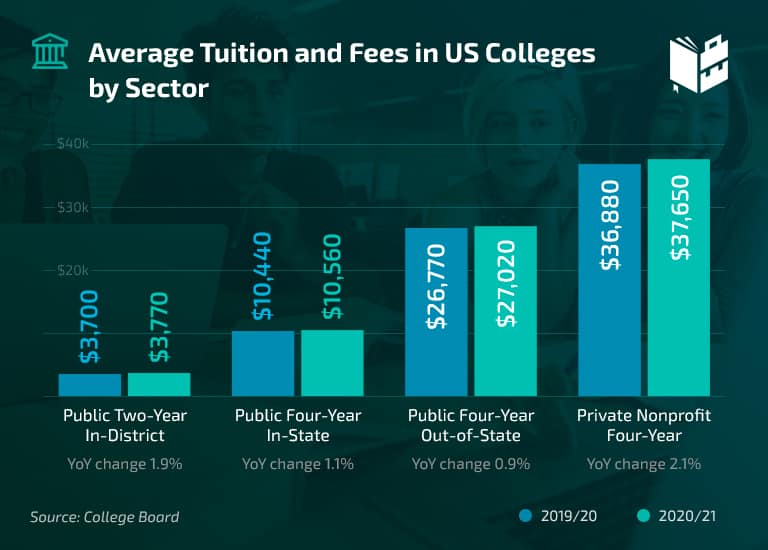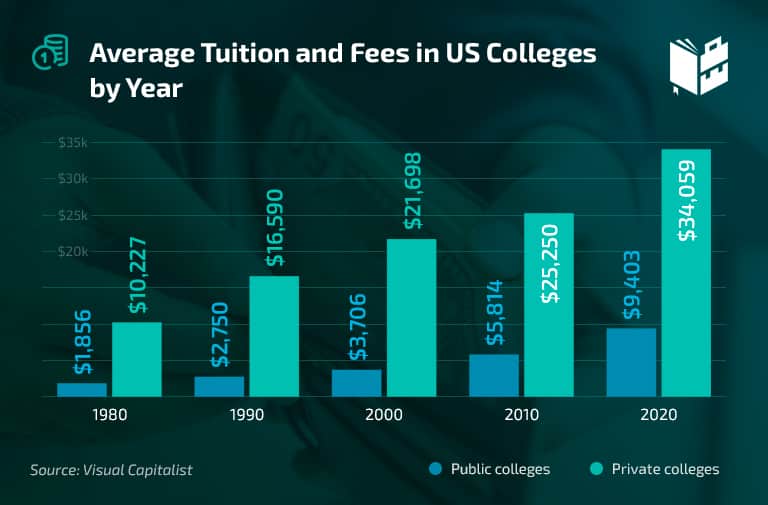Over the years, numerous studies have shown that most Americans view the college tuition increase as something inevitable and somewhat expected. However, such an attitude is one of the biggest contributing factors to problems with college tuition costs.
It is essential to understand that the educational system exists for the betterment of people. Such a realization could cause a much-needed change in the current higher education trends. The prices go up every year, yet we accept it without question. That has to change.
So, how much does college cost in the US? Read on to find out.
Top College Tuition Increase Statistics (Editor’s Choice)
- The average fee and tuition increase at four-year public colleges is 1.6% for in-state students.
- 15 states didn’t increase the average college tuition at two-year in-district institutions in 2021–22.
- Tuition at public two-year institutions in Wyoming is 37% higher in the 2021–22 academic year than five years before.
- At public national universities, the in-state college tuition and fee costs over time have increased the most over 20 years (211%).
- College tuition and fees in the US have increased by 1,200% between 1980 and 2020.
- Tuition and fees for Harvard students increased by 2.94% in 2021–22.
- The University of California will charge undergraduate students 4% more in fall 2022.
- 45% of the revenue generated from the increase in college tuition will be set aside as financial aid for students.
College Tuition Rise Statistics — New Data
1. The average in-state tuition and fees at public four-year institutions increased by more than 10% in six states between 2016–17 and 2021–22.
(College Board)
Simultaneously, a new report shows that average in-state tuition and fees at public four-year institutions fell in 18 states. In addition, it reveals that some public four-year institutions charge the same tuition to out-of-state students as to in-state students.
2. The average fee and college tuition increase in 2022 for in-state students at four-year public colleges is 1.6%.
(College Board)
Before the pandemic that caused a global economic crisis, the cost of attending a public four-year college has grown year after year. Statistics show that the average tuition and fees for in-state students at four-year public colleges have reached $10,740 in the 2021–22 academic year. Additionally, the cost at private four-year colleges has increased by 2.1% to $38,070.
3. The average college tuition didn’t increase at public two-year colleges in 15 states in the 2021–22 school year.
(College Board)
College tuition costs didn’t increase at public two-year colleges in California and Florida. What’s more, California hasn’t increased its tuition cost since 2012–13, nor has Florida since 2015–16.
4. Temple University has increased tuition by 3.9% for the 2022–23 school year.
(Inquirer)
The tuition for out-of-state students at Temple University has reached $30,864. The source cites inflationary costs as the main reason behind the increase. Moreover, the mandatory fees have also increased by $34, reaching $924. On the other hand, the tuition for in-state students has also risen, reaching $17,136.
5. Rising tuition costs statistics show that Wyoming sees a five-year tuition and fee increase of 37% at public two-year institutions in the 2021–22 academic year.
(College Board)
Between 2016–17 and 2021–22, tuition costs haven’t increased across all the states equally. For example, Wyoming is the state that increased tuition and fees costs for students at public two-year institutions.
Additionally, the average tuition and fees for full-time in-district students at the same institutions range from $1,430 in California to $8,600 in Vermont in 2021–22.
College Tuition Increase Over Time — Stats and Facts
6. The average college tuition and fees for full-time undergraduate students at private nonprofit four-year colleges have increased by 2.1% since 2020–21.
(College Board)
The latest trends in college pricing for 2021–22 show an $800 increase compared to the previous year. So, the tuition and fee price at private nonprofit four-year colleges amounts to $38,070.

7. In-state tuition and fees at public national universities have grown the most in the last 20 years (211%).
(US News)
According to college tuition increase statistics, the average tuition cost and fees for public and private national universities have risen significantly for in-state and out-of-state students since 2002. For example, the average tuition cost for in-state national university students is $11,631. In comparison, it was $3,738 in 2002.
The tuition and fees at public national universities for out-of-state students have risen 171% during the same time. In 2022, the tuition for out-of-state students was $28,238, compared to $10,409 two decades before.
8. The highest year-over-year college tuition increase rate was recorded in June 1982 — 14.2%.
(Visual Capitalist)
Conversely, the lowest year-over-year change in the average college tuition in the US so far has been in November 2020 — 0.6%. It was mainly because of the shift to online classes during the pandemic.
9. College tuition and fees in the US increased by 1,200% between 1980 and 2020.
(Visual Capitalist)
The data for 2020 shows that the average tuition cost was $9,403 in public colleges and $34,059 in private ones. Moreover, the cost of attending a public school was $1,856 in 1980. In addition, private schools used to cost $10,227.

Stats About Increase in College Tuition at Four-Year Colleges
10. The average price of tuition and fees at private four-year colleges increased by $7,930 over 10 years.
(Manhattan Institute)
Similarly, the price was $12,990 at the turn of the millennium when adjusted for inflation. Furthermore, the average published price for full-time enrollment in the 2019–20 school year at private colleges was $36,880.
Research suggests that the price of private colleges grew more than the price in any other sector.
11. Tuition and fees for Harvard students increased by 2.94% in 2021–22.
(College Tuition Compare)
Over time, the price of college has increased significantly for Harvard students, based on education statistics. In addition, tuition and fees usually rise between 3% and 4% percent each year. The increase from the 2020–21 school year means that graduate students at Harvard need to pay $52,170. On the other hand, tuition and fees at Harvard cost $55,587 for undergraduate students.
12. The undergraduate tuition at Boston University for 2021–22 is 3% higher than the previous year.
(College Tuition Compare)
The undergraduate tuition at Boston University in the 2021–22 academic year is $59,816. Furthermore, it was $58,072 a year ago. For graduate students, the tuition stands at $59,418, which saw a 3.04% increase from the previous year.
College Tuition Increase — Stats and Projections
13. The tuition cost will increase by 4% for undergraduate students entering the University of California in fall 2022.
(EdSource)
It’s estimated that the total annual cost of tuition in 2022–23 will amount to $13,104. In addition, that price would be frozen for this class of students during their enrollment, or six years.
14. First-year students at Boston University will have to pay $61,050 in fall 2022.
(College Tuition Compare)
The freshmen year will be the least expensive for students entering Boston University in fall 2022. Moreover, data about college tuition costs by year shows that the cost of the first year will be $64,326 in fall 2028. The year after that, it will cost $65,903. Thus, freshmen at Boston University will have to set aside $67,520 in 2030.
15. Tuition at top colleges will increase by 3.7% on average in 2023.
(Forbes)
The most recent Forbes rankings of the top 20 US colleges show that college tuition will increase between 1.8% and 5% in 2023. In addition, the average tuition cost is estimated at $58,396. The lowest one is expected at UCLA ($13,804), while Amherst College will have the highest tuition cost ($63,500).
16. 45% of the revenue generated from the college tuition increase will be set aside as financial aid for students in 2022–23.
(EdSource)
The University of California’s board approved a new tuition plan. According to the plan, nearly half of the mentioned revenue will be returned to students as financial help, thus reducing the number of student loan debt applicants. Moreover, the cap on a single year’s tuition increase will be 5% instead of 6%.
Conclusion
College costs are rising at an alarming rate. Interestingly, the college tuition increase rate isn’t the same at all higher education institutions. As we have seen, the price rises at different rates for in-state and out-of-state students.
Experts estimate that the number of graduates in debt will exponentially increase if the tuition price continues with its present pattern. However, college still proves to be a valuable investment to those who can afford it.